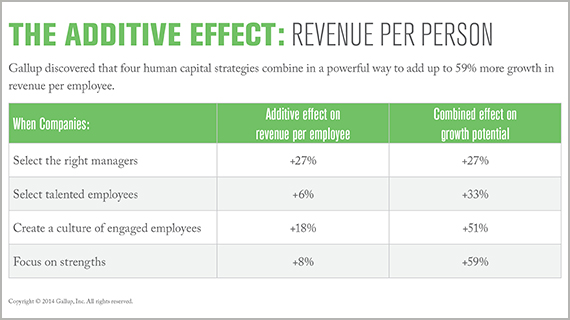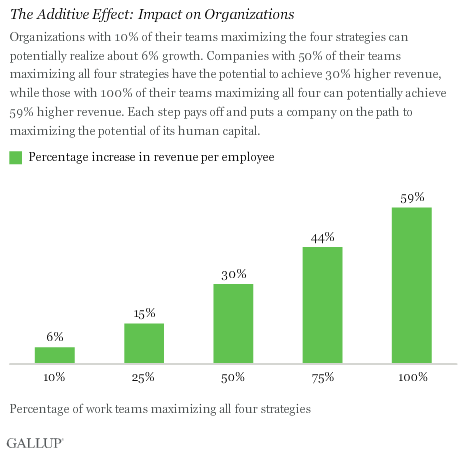The most critical of the four strategies is selecting and deploying the right managers.
Your company isn't growing fast enough. It's tempting to blame the economy, but plenty of companies have thrived during these tough times. Though you may think the problem is your technology or processes, the real problem is that you don't have enough star employees. Technologies and processes continue to evolve, but how companies manage and develop stars hasn't improved over the past decade.
Though researchers have made huge strides in understanding human behavior and motivation, few businesses are actually applying these findings. As a result, companies miss out on unprecedented opportunities for growth and revenue because they don't understand the impact of human nature in the workplace.
Gallup has spent decades studying human potential and how it can be harnessed to build better companies. While we've researched and developed various strategies to help companies tackle a range of problems, we've learned that certain solutions, when implemented together, can have an even more powerful effect than that of each in isolation. This is called the "additive effect."
In biological and chemical research, the term additive effect refers to combining multiple elements so that the results equal the sum of each element's effects. In other words, each element plays a unique role and has an added scientific value in predicting the outcome. Elements that aren't additive don't matter; work against the intended outcome; or are redundant, leading to wasted time and resources.
Similarly, Gallup discovered that four human capital strategies combine in a powerful way to add up to 59% more growth in revenue per employee. Each strategy has been widely tested and proven effective on its own. But by studying these strategies in various combinations across thousands of workgroups and organizations from a wide range of industries and countries, we've found that using them together leads to gains that more than double the effect of using any single strategy on its own.
Strategy 1: Select managers with natural talent
The most critical of the four strategies is selecting and deploying the right managers at all levels in the enterprise. Our recent article highlighted Gallup's research on why naturally talented managers are so important -- and why they are so rare. Only about one person in 10 has the natural talent to be a great manager.
For companies, deciding who should be named manager has a ripple effect on everything else. When a business gets this decision wrong, nothing fixes it. Bad managers drive talented employees away and ultimately damage customer relationships. Talented managers, on the other hand, attract and engage talented employees. They have a natural gift for developing employees' strengths and getting the most out of each person.
As we noted in the previous article, companies pick the wrong manager 82% of the time because they use the wrong criteria. The key to hiring the right managers is selecting candidates based on their specific talent to manage others, not their years of seniority or standout performance in their current role as an individual achiever. The best managers are gifted with the ability to inspire employees, drive outcomes, overcome adversity, hold people accountable, build strong relationships, and make tough decisions based on performance rather than politics. When companies systematically pick the right managers, they can achieve 27% higher revenue per employee than average.
Strategy 2: Select the right individual contributors
Though 27% is a lot, it's less than half of what companies could achieve by combining the other elements. In addition to hiring the right managers, companies that select and develop employees based on their natural talents have an opportunity to accelerate business growth. The problem is that companies tend to concentrate on candidates' education, skills, and work experience while overlooking whether each candidate has the right natural talent to excel in a role.
By using a scientific, systematic approach with each hire, companies can reduce variance and make performance more predictable. This process streamlines decision making, increases productivity, removes bias, improves diversity, and enhances customer and employee engagement. The additive effect of selecting naturally talented individual contributors is 6% higher revenue per employee, for a combined gain of up to 33% higher growth potential.
Strategy 3: Engage employees
Naturally talented managers play an essential role in creating an engaged workforce, explaining at least 70% of the variance in the engagement of their teams. Companies that select and develop a critical mass of these managers achieve substantially higher levels of engagement and growth. This doesn't happen by chance.
Engaging employees begins with asking the right performance-based questions. Gallup's 12-item employee engagement assessment, the Q12, measures employees' involvement in and enthusiasm for their jobs and workplace, which link directly to their willingness to go the extra mile for the company and customers.
But creating a culture of employee engagement requires much more than a survey. It demands a strategy, accountability, great communication, and manager and employee development plans that are aligned with scientifically tested metrics and performance outcomes. Gallup has found seven key elements in companies that have created extremely high levels of engagement. By using the right employee engagement approach, companies see improvements in productivity, profitability, retention, safety, quality, and customer engagement.
Currently, most U.S. companies are a long way off from these gains. In 2012, less than one-third of American workers were engaged, compared with 52% who were not engaged and 18% who were actively disengaged. We estimate that actively disengaged workers alone cost the U.S. between $450 billion and $550 billion per year. Worldwide, the situation is even worse: Among the 142 countries included in Gallup's global study, only 13% of employees were engaged in their jobs, while 63% were not engaged and 24% were actively disengaged.
Still, several companies have bucked the trend and engaged their workforces, seeing up to 147% higher earnings per share (EPS) compared with their competitors. These organizations held their own in a down economy, then outpaced the competition as the economy improved. With the additive effect, a culture of employee engagement can lead to up to 18% higher revenue per employee, for a total of 51% higher growth potential when combined with selecting the right managers and individual contributors.
When managers focus on employees' strengths, 61% of workers are engaged, and only 1% are actively disengaged.
Strategy 4: Focus on strengths
When businesses select the right managers and employees and build workplace engagement, they gain a serious competitive advantage -- but there's still more they can do to maximize their human capital. Companies get the most from their workforce when they help employees identify and use their strengths. All employees have strengths -- the unique combination of talents, knowledge, and skills that help them do what they do best every day. These strengths serve as employees' -- and the company's -- greatest opportunities for success. Employees who use their strengths every day are six times more likely to be engaged at work.
Building on employees' strengths is more effective than trying to improve their weaknesses. Weaknesses shouldn't be ignored, but a strengths focus offers managers a better chance to develop individuals in the context of who they are, instead of attempting to change their personalities. In a study of U.S. employees, Gallup found that when managers focus on employees' strengths, 61% of workers are engaged and only 1% are actively disengaged -- a dramatically different result than what surveys find of employees generally. When employees use their strengths, they're more engaged, perform better, and are less likely to leave their company.
What a company does or fails to do with the strengths of its workforce has enormous implications for its future. Gallup has found that when teams learn and focus on their strengths every day, their productivity improves. This produces an additive effect of up to 8% higher revenue per employee, for a total of 59% higher revenue growth potential.

It all adds up
From Gallup's analysis of U.S. organizations, we estimate that less than 1% of teams fully apply all four of these human capital strategies. This highlights an area of tremendous opportunity for companies to accelerate their growth.
And businesses can implement the four strategies in whatever order best meets their particular needs. For instance, some companies may have an effective employee engagement system in place but lack the right managers. Selecting managers for natural talent may be their best next step. Other companies may have an employee engagement program that doesn't move the numbers because they're using a competency model focused on fixing weaknesses. Their starting point may be to implement an actionable system to develop employees' strengths. Still others may see wide variation in performance among individual contributors. Their best course may be to implement an assessment system that pairs top managers with high-potential employees.
As companies implement these four strategies, they maximize the potential of their human capital. When talented employees work in jobs for which they're suited under the direction of talented managers, they're more engaged and able to maximize their strengths. This combination leads to everything companies want -- more sales, increased productivity and profitability, lower turnover and absenteeism, fewer accidents and defects, and a culture of high customer engagement.
Of course, 59% higher revenue won't happen overnight. But by building on these strategies, companies' growth potential increases steadily and incrementally. Organizations with 10% of their teams maximizing the four strategies can potentially realize about 6% growth. And those with 50% of their teams maximizing all four have the potential to achieve 30% higher revenue. Each step pays off and puts a company on the path to maximizing its human capital capacity.

If a company isn't using these four strategies, then its workforce isn't operating at full potential, and the business is likely missing opportunities every day. However, each manager-led team that maximizes the additive effect puts the organization in an incrementally better position to win.
A version of this article originally appeared on the HBR Blog Network.
Methods
Gallup's selection database, built over four decades, includes 12,000 items gathered from more than 500 organizations in 50 countries and 20 industries. Our employee engagement database includes data from more than 3.1 million teams and 27 million employees. Our strengths-based development instrument, the Clifton StrengthsFinder, has been used to identify the talents of more than 10 million individuals. The findings presented in the article are based on our meta-analytic research, studying the relationship between each of the four additive effect strategies and financial performance across organizations. We then conducted meta-analyses studying the relationships between each of the strategies. Next, we calculated the semi-partial correlation of each strategy to financial performance to estimate the unique contribution of each strategy. Finally, we conducted utility analysis to estimate the percent increase in output (revenue per person) for each of the strategies. The meta-analyses included observations from more than 33,000 managers and their business units. The findings assume that other variables that influence business performance are held constant. Changes in overall economic climate and competitive landscape, among other factors, can influence the aggregate findings for any given organization.
